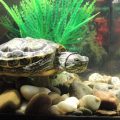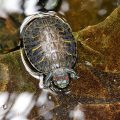Reptiles like the red eared slider turtle do not hibernate but in fact, brumate. This period of brumation is signified by less turtle activity save for the occasional surfacing for water and food. Red ear sliders can be found in brumation at the bottom of ponds or shallow lakes over the winter season. It is usually around October, when temperatures fall below 10 degrees Celsius, that red eared sliders are less active.
The Red Eared Slider is a semi-aquatic turtle which can safely brumate indoors or outdoors if conditions are safe and given that the water it is in does not freeze. If the turtle is kept in a pond outdoors, it will manage and respond to changes and shifts in temperature as well as the length of sunlight and it will know instinctively when to ready itself to brumate.
Artificial Stimulation
An animal living in a tank indoors will need artificial stimulation with the aide of its caregiver in order for these changes to come about. You should consult with your vet, check local pet clubs for information and ask experienced hobbyists if you are unsure of this period or if you are not confident of recognizing signs the turtle may display of its readiness.
The red eared slider is a semi-aquatic turtle whose sex is determined by the temperature it is in during a specific period of its existence. It is also a reptile whose breeding success hinge on periods of brumation. Feed your turtle a correct amount of vitamin A before its fasting period during winter. You will want to up its meals with foods rich in vitamin A such as carrots, squash, kale, broccoli, collard greens, dandelions, alfalfa, sweet potatoes, cantaloupe and peaches.
Fiber for Brumation
You will also want to increase its fiber intake and include timothy hay and alfalfa. Should your pet already have these present in its normal diet then just feed your pet as you usually would. You will need to fast the turtle 2 – 6 weeks before its brumation to make sure it has no undigested food in its system. Brumating a turtle a month after it had last eaten could die. Brumation should instead be delayed to avoid undigested food to decay and cause fatal bacterial infections.
The caregiver is to reduce the photoperiod in the turtle’s tank a little at a time over a period of time. The turtle is then put on fast for 10 days to ensure its bowels are empty. During the last 3 days of fasting the slider is to be soaked in water to make absolute certain that it has emptied its bowels of all contents.
Most turtles brumate from 2 – 4 months. Other species brumate for up to 6 months but it should be noted that this length of time is not required; to shake off uncertainty consult with your vet.






 Author and long-time animal lover. Sharing knowledge on pet care through experience and the written word.
Author and long-time animal lover. Sharing knowledge on pet care through experience and the written word.